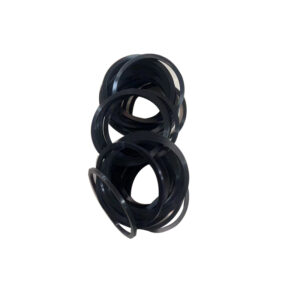Table of Contents
ToggleAre O-Rings Better Than Gaskets?
The question of whether O-rings are superior to gaskets is not a matter of inherent superiority but of application-specific suitability. Both sealing solutions play critical roles in engineering and industrial systems, yet their effectiveness hinges on distinct design principles, operational conditions, and mechanical requirements. Below, we dissect their differences, strengths, and limitations to determine which seal excels in specific scenarios.


1. Fundamental Definitions
What Is an O-Ring?
An O-ring is a toroidal (doughnut-shaped) elastomer seal designed to fit into a precisely machined groove. When compressed, it creates a leak-resistant barrier, leveraging system pressure to enhance its sealing capability. O-rings are self-energizing, meaning pressure deforms the elastomer slightly, forcing it tighter against the mating surfaces. This makes them ideal for both static and dynamic applications, such as hydraulic pistons, rotating shafts, and high-pressure fittings.
What Is a Gasket?
A gasket is a flat or profiled seal made from materials like rubber, cork, metal, or composite sheets. It fills gaps between stationary surfaces (e.g., pipe flanges, engine blocks) to prevent leaks. Gaskets compensate for surface imperfections, thermal expansion, or uneven bolt loads, making them indispensable for large, irregular, or non-circular interfaces.
2. Head-to-Head Comparison
To evaluate whether O-rings or gaskets are “better,” we analyze key factors critical to sealing performance:
| Criteria | O-Rings | Gaskets |
| Design & Function | Circular, groove-mounted elastomer seals. | Flat or shaped seals placed between stationary surfaces. |
| Pressure Resistance | Handle extreme pressure (up to 5,000+ PSI) with backup rings. | Suitable for low-to-moderate pressure; prone to extrusion at high pressure. |
| Temperature Range | −60°C to +300°C (silicone, FFKM). | Up to 1,000°C with metal gaskets (e.g., exhaust systems). |
| Dynamic vs. Static Use | Excel in dynamic applications (motion, vibration). | Designed for static, non-moving joints. |
| Surface Compatibility | Require smooth, machined grooves for optimal performance. | Tolerate uneven or corroded surfaces. |
| Cost & Availability | Low-cost standard sizes; specialty materials (FFKM) can be expensive. | Range from cheap rubber sheets to costly metal composites. |
| Installation Complexity | Require precise groove dimensions. | Easier to install on flat surfaces. |
3. When to Choose O-Rings
O-rings dominate in scenarios demanding precision, motion tolerance, or compact designs:
- Dynamic Sealing:
- Hydraulic/pneumatic cylinders, rotating shafts, and reciprocating pistons.
- Example: A hydraulic excavator’s piston relies on Viton® O-rings to withstand high-pressure fluid and continuous motion.
- High-Pressure Systems:
- Fuel injectors, hydraulic pumps, and pressurized valves.
- Example: PTFE-jacketed O-rings prevent extrusion in oil and gas pipelines.
- Space-Constrained Applications:
- Compact machinery, valves, or automotive components where space is limited.
- Chemical/Fluid Resistance:
- Nitrile (NBR) for petroleum, Viton® for acids, and EPDM for water/steam.
4. When to Choose Gaskets
Gaskets are unmatched in static, large-scale, or high-temperature environments:
- Static Seals:
- Pipe flanges, engine heads, and tank lids.
- Example: A graphite gasket seals a boiler flange exposed to 800°C steam.
- Irregular or Large Surfaces:
- Compensate for warped metal, uneven bolt loads, or thermal expansion.
- Example: Cork/rubber composite gaskets in vintage car engines.
- Extreme Temperatures:
- Metal (stainless steel, copper) or PTFE gaskets in exhaust systems or chemical reactors.
- Cost-Effective Repairs:
- Pre-cut rubber gaskets for low-pressure plumbing or HVAC systems.
5. Limitations of Each Seal
O-Ring Drawbacks
- Groove Dependency: Require precisely machined grooves; improper sizing leads to leaks.
- Material Degradation: Susceptible to UV, ozone, and chemical swelling (e.g., NBR in acetone).
- Extrusion Risk: High-pressure systems demand backup rings to prevent seal failure.
Gasket Drawbacks
- Static Use Only: Fail under dynamic motion or vibration.
- Bulkier Design: Unsuitable for compact spaces.
- Frequent Replacement: Prone to compression set or corrosion over time.
6. Hybrid Solutions: Combining Strengths
In complex systems, hybrid seals merge O-rings and gaskets:
- O-Rings with Backup Washers: Prevent extrusion in high-pressure hydraulic systems.
- Gaskets with Embedded O-Rings: Enhance sealing on irregular surfaces (e.g., aerospace fuel tanks).
7. Industry-Specific Applications
- Automotive:
- O-rings in fuel injectors; gaskets in engine blocks.
- Aerospace:
- Viton® O-rings in hydraulic systems; metal gaskets in jet engines.
- Oil & Gas:
- FFKM O-rings for chemical resistance; spiral-wound gaskets in pipelines.
- HVAC:
- EPDM gaskets for ductwork; silicone O-rings in refrigeration units.
8. Cost and Maintenance Considerations
- O-Rings:
- Lower lifecycle costs in dynamic systems but require precise maintenance.
- Example: Replacing a
- 2NitrileO−ringinapumpvs.repairinga
- 2NitrileO−ringinapumpvs.repairinga200 gasket failure.
- Gaskets:
- Higher upfront costs for custom shapes but longer lifespan in static setups.
- Example: A $50 metal gasket lasts years in an industrial boiler.
9. Decision-Making Checklist
Ask these questions to choose the right seal:
- Is there motion or vibration?
- Yes → O-ring. No → Gasket.
- What’s the pressure rating?
- High (1,000+ PSI) → O-ring. Low/Moderate → Gasket.
- Surface condition?
- Smooth, machined → O-ring. Uneven → Gasket.
- Temperature extremes?
- Beyond 300°C → Metal gasket. Within range → O-ring.
10. Real-World Examples
- Hydraulic Press Failure:
- A cracked gasket caused a leak in a stationary flange. Replaced with a rubber gasket.
- Lesson: Gaskets are optimal for static, low-pressure joints.
- Rotary Pump Overhaul:
- Worn O-rings led to fluid leakage. Installed FFKM O-rings for chemical resistance.
- Lesson: O-rings thrive in dynamic, high-pressure environments.
Conclusion
O-rings are not universally “better” than gaskets—they serve distinct purposes. O-rings shine in dynamic, high-pressure, or compact systems, while gaskets dominate static, high-temperature, or irregular applications. The optimal choice hinges on motion, pressure, surface condition, and environmental factors. By aligning the seal type with operational demands, engineers ensure reliability, cost efficiency, and longevity. Whether repairing a faucet or designing a jet engine, understanding this balance is key to sealing success.



Leave A Comment